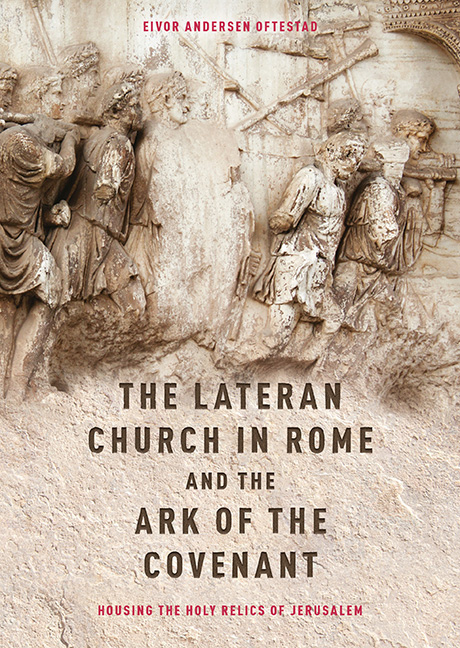 The Lateran Church in Rome and the Ark of the Covenant: Housing the Holy Relics of Jerusalem
The Lateran Church in Rome and the Ark of the Covenant: Housing the Holy Relics of Jerusalem Book contents
- Frontmatter
- Dedication
- Contents
- List of Tables
- Acknowledgements
- List of Abbreviations
- Author's Note
- Prologue
- 1 Introduction
- 2 The Description of the Lateran Church
- 3 In the Roman Context
- 4 In the Northern French Context
- 5 In the Jerusalem Context
- 6 The Temple of the New Covenant
- 7 Nikolaus Maniacutius and John the Deacon
- Epilogue
- Appendix 1 Manuscripts Transmitting the Descriptio Lateranensis Ecclesiae
- Appendix 2 Different Versions of the Descriptio Lateranensis Ecclesiae
- Appendix 3 Edition and Translation of the Descriptio Lateranensis Ecclesiae (Reg. lat. 712)
- Bibliography
- Index
- Other volumes in Studies in the History of Medieval Religion
Appendix 3 - Edition and Translation of the Descriptio Lateranensis Ecclesiae (Reg. lat. 712)
Published online by Cambridge University Press: 31 August 2019
- Frontmatter
- Dedication
- Contents
- List of Tables
- Acknowledgements
- List of Abbreviations
- Author's Note
- Prologue
- 1 Introduction
- 2 The Description of the Lateran Church
- 3 In the Roman Context
- 4 In the Northern French Context
- 5 In the Jerusalem Context
- 6 The Temple of the New Covenant
- 7 Nikolaus Maniacutius and John the Deacon
- Epilogue
- Appendix 1 Manuscripts Transmitting the Descriptio Lateranensis Ecclesiae
- Appendix 2 Different Versions of the Descriptio Lateranensis Ecclesiae
- Appendix 3 Edition and Translation of the Descriptio Lateranensis Ecclesiae (Reg. lat. 712)
- Bibliography
- Index
- Other volumes in Studies in the History of Medieval Religion
Summary
In 1689 Mabillon and Germain edited a first version of the Descriptio from an unknown manuscript, now probably lost. Not until the twentieth century did two critical editions emerge. The first one was Philip Lauer's publication of 1911, based on Mabillon and Germain's edition but with indications of several variations of the text. The second one, Valentini and Zuchetti's edition of 1946, was based on the version of John the Deacon in ACL A 70.
For the purposes of this book, one of the representative versions of Descriptio is edited below. This edition is based on a single manuscript, Reg. lat. 712, the version that was also the basis for the edition by D. Giorgi of 1744. The edition follows the articulation of the manuscript (the structure of breaks and sections). In the manuscript, sections are introduced with large initials equivalent in depth to between two and eight lines of text. Within the sections there are some subdivisions introduced with bold initials on the same line as the text.
In contrast to Giorgi's normalized edition, the present edition largely follows the rules of diplomatarian editions. There is a minimum of editorial interventions in the text – the spacing and orthography are given as in the manuscript with dissolved abbreviations. Some obvious omissions and spelling errors are commented on. The edition mostly follows the punctuation of the manuscript, the sentence divisions being indicated by capitals, punctus and punctus interrogativus. Given the different logic of medieval and modern forms of punctuation, some modernization has been necessary.
The Roman numbers indicated in brackets refer to Vogel's analysis of the elements of the text. Although they disturb the text to some extent, they have been included to facilitate further comparative study.
Text
(II) In nomine sancte et individue trinitatis incipit scriptum de supremo sanctuario sancte dei Romane idest lateranensis, [ecclesie], compositum, que patriarchalis est, que sancte sedis apostolice dignitatem et excellentiam que dono gratie dei super omnes ecclesias totius orbis terrarum obtinet dominatum et principatum, que divino nutu apostolici culminis et romani imperii nomen possidet gloriosum.
- Type
- Chapter
- Information
- The Lateran Church in Rome and the Ark of the Covenant: Housing the Holy Relics of JerusalemWith an Edition and Translation of the Descriptio Lateranensis Ecclesiae (Bav Reg. Lat. 712), pp. 216 - 232Publisher: Boydell & BrewerPrint publication year: 2019


